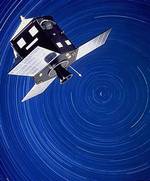|
I used this information to plot the brightest stars, and cause them to revolve about Polaris (the North Star) very slowly, as the stars appear to do. Like the night sky, this is a sidereal time clock -- it takes nearly 24 hours for the stars to fully rotate. You'll notice some familiar constellations, such as the Big Dipper in there. As the stars cross zero and 180 degrees, indicated by the center line, the clock plays an individual note, or chime for each star. The pitch of the chime is based on the star's BV measurement (which roughly corresponds to color or temperature). The volume is based on the star's magnitude, or apparent brightness, and the stereo panning is based on the position on the screen (use headphones to hear it better). Basically, this is a very literal kind of "music of the spheres," and is typical of my projects, which often involve circles and music. This idea for making a music box out of stars was a natural progression from some previous projects of mine, like the Whitney Music Box, and Musical Chess, which you might also enjoy. Jim Bumgardner, October 3rd 2009
January 2010: A few of you have requested a stand-alone version to play on your computers without Internet access. Here it is (15 megs). You'll need the stand-alone version of the Adobe Flash player to run it.
October 2009: Here's a 10-minute MP3 excerpt of the sequence. Here's a 5-minute excerpt that crosses the Pleiades system. This was produced using a different synthesis system that also uses Parallax information to produce a doppler effect on some of the stars.
|
more wondrous toys from jbum:
whitney music box colrpickr mandala of the day mind power amazing ascii cam wheel of lunch printable puzzles jim's blog
|
